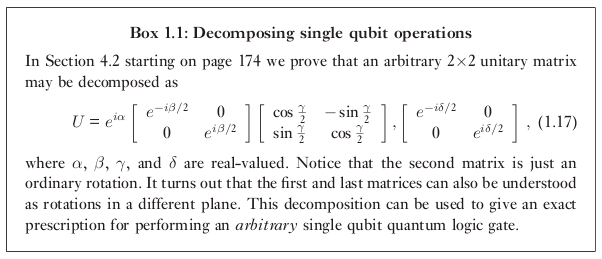
Depolarization noise produces a density matrix which is a convex combination of an identity (representing full depolarization) and the original system density matrix: (1-η)ρ + ηI/2n, where 0.0 ≤ η ≤ 1.0 is the noise level. It is easy to show that unitary transformations have no effect on a fully depolarized density matrix, since U*I*U† = U*U† = I.
Here we will use the state vector representation to show that unitary transformations have no effect on a fully depolarized qubit.
Pure State Superposition
First consider amplitudes of a pure state superposition of |0> and |1>:
x a
|0> 1/sqrt(2)
|1> 1/sqrt(2)
The amplitude squared represents a probability, so we have P(|0>) = P(|1>) = 1/2.
If we perform a Hadamard transformation, the state becomes:
(H|0> + H|1>)/sqrt(2) = ( (|0> + |1>)/sqrt(2) + (|0> - |1>)/sqrt(2) )/sqrt(2) = |0>
x a
|0> 1
|1> 0
So now P(|0>) = 1, P(|1>) = 0, and in general unitary transformations on pure states
change the measurement probabilities.
Fully Depolarized Qubit
A fully depolarized qubit will have P(|0>) = P(|1>) = 1/2, represented by a mixed state:
p0 = 1/2 p1 = 1/2
x a x a
|0> 1 |0> 0
|1> 0 |1> 1
This is not a superposition. The state is either |0> or |1>
but we do not know which, and either state is equally likely.
Now perform any unitary transformation on this mixed state. As illustrated below from [1], an arbitrary single qubit unitary transformation can be represented by a product of rotations. Omitting the exponential phase terms, since they do not affect the measurement probabilities (i.e. amplitude squared), and using c and s for the cosine and sine, we have:
U|0> = c|0> + s|1> U|1> = -s|0> + c|1>The state becomes:
p0 = 1/2 p1 = 1/2
x a x a
|0> c |0> -s
|1> s |1> c
with measurement probabilities still equally likely:
P(|0>) = (1/2) c2 + (1/2) (-s)2 = 1/2 P(|1>) = (1/2) s2 + (1/2) c2 = 1/2To confirm that further unitary transformations will not affect the measurement probabilities, use d and e for the cosine and sine in transformation V:
V(c|0> + s|1>) = dc|0> + ec|1> -es|0> + ds|1> = (dc-es)|0> + (ec+ds)|1> V(-s|0> + c|1>) = -ds|0> -es|1> -ec|0> + dc|1> = (-ds-ec)|0> + (-es+dc)|1>The state becomes:
p0 = 1/2 p1 = 1/2
x a x a
|0> dc-es |0> -ds-ec
|1> ec+ds |1> -es+dc
with measurement probabilities still equally likely, e.g.:
P(|0>) = (1/2) (dc-es)2 + (1/2) (-ds-ec)2
= (1/2) (d2c2 + e2s2 -2dces + d2s2 + e2c2 +2dsec)
= (1/2) (d2(c2 + s2) + e2(s2 + c2))
= (1/2) (d2 + e2) = 1/2
Partially Depolarized Qubit
A general partially depolarized qubit can be modeled as a combination of an original system state, with complex amplitudes α and β, and the state of a fully depolarized qubit, in proportions (1-η) and η, where 0.0 ≤ η ≤ 1.0 is the noise level:
(1-η) η
p0 = 1/2 p1 = 1/2
x a x a x a
|0> α |0> 1 |0> 0
|1> β |1> 0 |1> 1
The measurement probabilities are:
P(|0>) = (1-η)|α|2 + η/2 P(|1>) = (1-η)|β|2 + η/2This can be simulated by setting the state amplitudes using convex combinations for the magnitude and phase:
x a
|0> sqrt((1-η)|α|2 + η/2) ei(1-η)∠α
|1> sqrt((1-η)|β|2 + η/2) ei(1-η)∠β
As η is varied from 0 to 1, the complex state amplitudes vary linearly from their
original values to the fully depolarized values.
This produces correct measurements, but can not be used for any further computations; a unitary transformation applied to this simulated partially depolarized state is not equivalent to operating on the original state and then depolarizing.
For example, if a pure state superposition is depolarized, the simulated state amplitudes remain 1/sqrt(2), independent of η, and then performing a Hadamard transformation yields P(|0>) = 1. But if the Hadamard transformation is performed first, we have P(|0>) = 1 before depolarizing, and then after depolarizing P(|0>) = 1-η/2.
[1] Quantum Computation and Quantum Information, 10th Anniversary Edition, Michael A. Nielsen & Isaac L. Chuang, Cambridge University Press, 2010, page 20:
